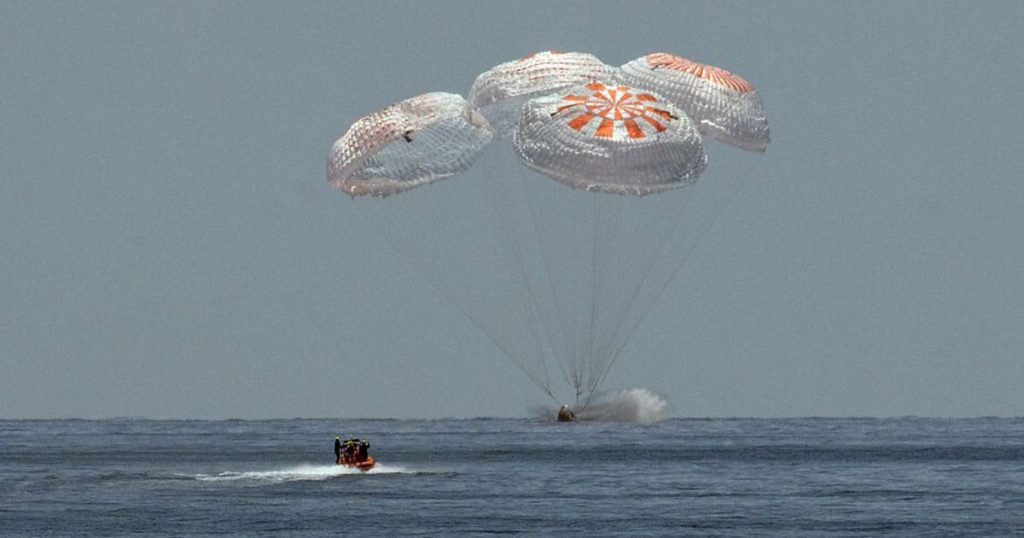Orion spacecraft NASAUS space agency, It landed safely on Sunday the 11th, after spending 25 days in space🇧🇷 Arrived at 2:40 PM (Brasilia time) in the Pacific Ocean, off the coast of Baja California, Mexico. This event marked the conclusion of the Artemis I mission, an uncrewed mission that was a rehearsal for returning man to the Moon.
The landing, according to NASA, is the last stage of the mission, which began with the successful launch of the Space Launch System (SLS) rocket on November 16 from Launch Pad 39B at the Kennedy Space Center in Florida, in the United States. . NASA tested Orion in the harsh environment of deep space before, over the next few years, astronauts aboard Artemis II.
“The landing of the Orion spacecraft, which occurred 50 years before the Apollo 17 landing on the Moon, is the culmination of Artemis I’s achievement. From launching the world’s most powerful rocket to the extraordinary flight around the Moon and back to Earth, this flight test is the ultimate in flight,” said the NASA Administrator. Bill Nelson “A huge step forward in the Artemis generation of lunar exploration”.
“For years, thousands of individuals have dedicated themselves to this mission, which inspires the world to work together to reach the pristine cosmic shores. Today is a great victory for NASA, the United States, our international partners, and all of humanity.”
It is a great victory for NASA, for the United States, for our international partners, and for all of humanity.
Bill Nelson, NASA Administrator
During the mission, Orion made two lunar flybys, reaching 129 kilometers from the lunar surface. At its greatest distance during the mission, the capsule traveled nearly 435,000 kilometers from Earth, more than 1,000 times farther than where the International Space Station (ISS) orbits our planet, to deliberately depress systems ahead of a crewed flight.
“With Orion safely back on Earth, we can begin to see our next mission on the horizon, which will take crews to the Moon for the first time as part of the next era of exploration,” said Jim Frey, Associate Administrator at NASA. “This begins our path to a regular rhythm of missions and a permanent human presence on the Moon for scientific discovery and preparation for human missions to Mars.”
Before entering Earth’s atmosphere, the crew module separated from its service module, thrust provided by the European Space Agency (ESA).
During its return to Earth, Orion endured temperatures of about 2,760 degrees Celsius, which is half the surface temperature of the Sun. At about 20 minutes, the capsule’s speed was gradually slowed down by its parachute-assisted descent.
The transmission shows the moment of descent
There was live coverage of the event, which started at 1 p.m. (Brasilia time), until from this link🇧🇷 The Orion spacecraft reached the Pacific Ocean at 2:40 PM and was celebrated by members of the US space agency:
During the test flight, Orion stayed in space longer than any spacecraft designed for astronauts without docking with a space station. While in distant lunar orbit, the spacecraft surpassed the distance record for a spacecraft designed to carry humans, previously set during Apollo 13.
“Orion has returned from the Moon and returned safely to planet Earth,” said Mike Sarafin, Artemis I mission manager. “Orion can withstand the extreme conditions of returning through Earth’s atmosphere from lunar speeds.”
NASA crews are working to recover spacecraft
NASA recovery teams are now working to ensure that Orion will return home. The group is comprised of members of the U.S. Department of Defense, Space Force weather specialists, and Air Force professionals, as well as space agency engineers and technicians.
Orion is expected to return to shore in the coming days, where technicians will unload the spacecraft and transport it by truck to Kennedy Space Center. Then the capsule and its heat shield will be tested and analyzed over several months.
The Artemis I mission was the first integrated test of NASA’s deep space exploration systems – the Orion spacecraft, SLS rockets and ground support systems – and was supported by thousands of people around the world.
With the Artemis missions, NASA’s goal is to land the first woman and first black person on the Moon, paving the way for the Moon’s long-term existence and serving as a “stepping stone” for astronauts on their way to Mars. 🇧🇷With information from NASA

“Incurable thinker. Food aficionado. Subtly charming alcohol scholar. Pop culture advocate.”






More Stories
NASA Releases Selfie of Perseverance Rover Working on Mars
NVIDIA driver includes hidden Final Fantasy XVI profile
PlayStation Plus Extra and Premium saw a significant drop in players in July